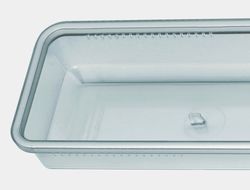For this reason, Sonderhoff as sealant specialist have developed two new types of addition-crosslinking silicone foam sealants, FERMASIL® 91 and FERMASIL® 93, ready for series production, which satisfy the highest impermeability requirements of the industry. The innovation in product development is that the silicone foam sealants harden at room temperature within a relative short time. They are dry-to-touch after just 10 to 12 minutes at room temperature. The major advantage for users: Room temperature crosslinking (RTC) silicone foam sealants from Sonderhoff Chemicals do not need an annealing furnace to cure the sealant.
Room temperature crosslinking silicone foam sealants make the annealing furnaces redundant
However, conventional 2-Component silicone systems, which do not fully cure at room temperature, must be cured in a tempering process so that they are cured within an acceptable time frame and have a good compression set. These silicone sealants are normally tempered in a first stage for some minutes at approx. 70° C and then again at about 130° C for the same time. As well as the energy costs, the curing of a silicone seal in the annealing furnace is also an additional waiting period, which disrupts an overall process that focuses on efficiency and that again costs further money.
But above all, a tempering process is always connected with the procurement of a furnace. For large components, the process is also intensive in terms of the required space and, therefore, costs. Sonderhoff can offer a solution, room temperature crosslinking silicone foam sealants, which do not require an annealing furnace. The advantage for the customer is that there are no investment costs for an annealing furnace. Even if the client already has a furnace, the new silicone sealants are of interest to him because they help to save energy costs and additional production stages. This makes production more efficient.
The FERMASIL® 91 silicone foam system with a lower viscosity of up to 25,000 mPa?s has been developed for groove applications and the FERMASIL® 93 thixotropic system with a viscosity of 80 to 130,000 mPa?s for applications on even or inclined surfaces. The application process takes place with a 2-component low-pressure mixing and dosing system from Sonderhoff Engineering.
Mechanical and chemical properties are preserved, even under extreme operating conditions
The silicone foam sealings from Sonderhoff can be used at temperatures from - 50° to + 180° C, and even up to + 350° C in the short term. The mechanical and chemical properties of these sealings are also maintained under extreme operating conditions. As foam silicone sealants have a closed cell structure, they absorb only small quantities of water, even in an unpressed state. They are hydrolytically stable, making them absolutely tropicalized and moisture-proof, as well as UV-stable for applications with direct sunlight.
For components, which must be opened and closed with varying frequency when installed, the compression set, the measure for the reset ability of the foam sealant after compression, is a decisive criterion. The leak-proof tightness of the component, which is achieved by compressing the sealing, must not be affected by repeated opening and closing. The mechanical values such as the resetting properties of the silicone foam system from Sonderhoff are maintained, even after years in permanent use. The compression set is very low with the new silicone sealings. FERMASIL® 93 has a compression set of < 15%, while it is just < 10% for FERMASIL® 91. Both values of the compression set are tested under conditions 22 hours, 30% compression and at 130° C. Also with repeated compression and at a temperature of up to 180° C the compressibility of the silicone foam sealings from Sonderhoff needed for the sealing effect is retained and the sealed parts remain leak-proof even after years.
The compression set is also good enough without tempering so that the component, equipped with the new FERMASIL® 93 or FERMASIL® 91 silicone sealants, passes the ATEX test standards (the component is tested together with the sealing as one system). In the EU, the ATEX directive 94/9/EC (“explosive atmosphere”) regulates and monitors the flawless use and application of equipment in potentially explosive surroundings, which are used in underground operations or other explosive areas. When an appliance is used in such a sensitive surrounding, the relevant high requirements also apply for the sealants used. The strict test conditions include temperature tests in the range of -50° C to +100° C with subsequent leak tests against foreign bodies and water to the highest criteria, which are comparable with the very high IP66 class (“ingress protection”).
Product innovations by Sonderhoff satisfy increasing demands on sealants
Sonderhoff has set itself the objective of constantly analyzing the development trends in the various industries of its customers and converting the knowledge acquired here into product innovations, which satisfy the increasing demands on sealants. FERMASIL® 91 and FERMASIL® 93 silicone foam sealants, which become cured at room temperature, are a good example of many. Increasing energy costs are a pressing issue also for the industrial clients of Sonderhoff to remain competitive. With energy and cost-saving silicone foam sealings, Sonderhoff is making its contribution to this.

